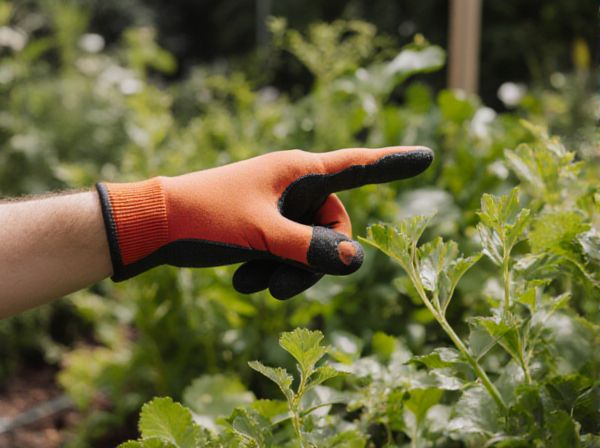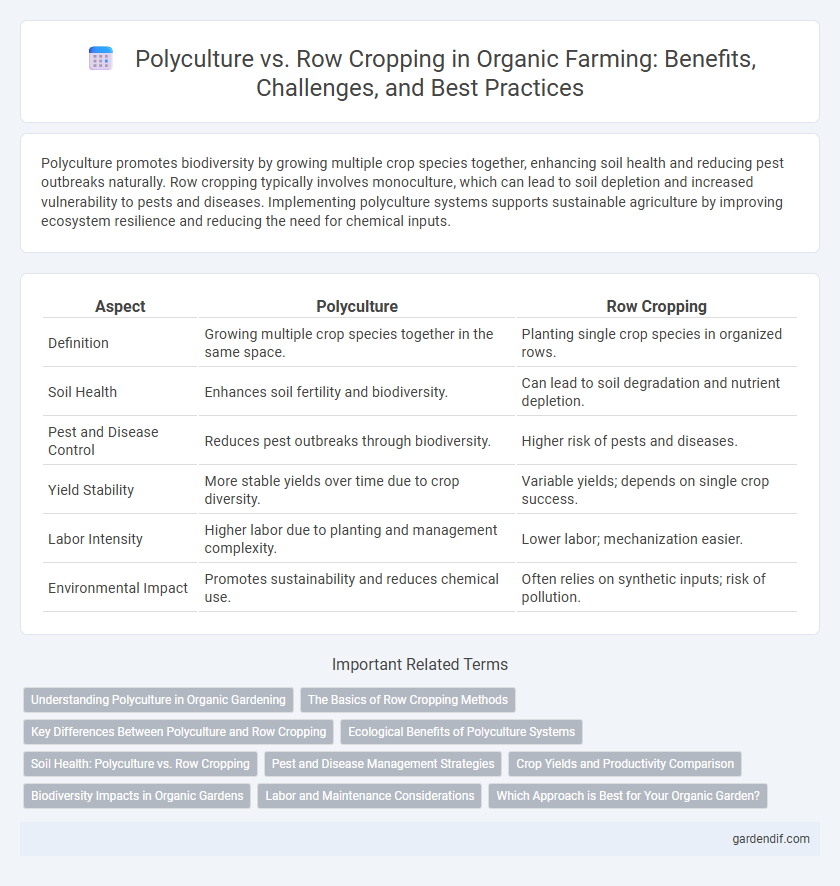
Polyculture vs Row Cropping Illustration
Polyculture promotes biodiversity by growing multiple crop species together, enhancing soil health and reducing pest outbreaks naturally. Row cropping typically involves monoculture, which can lead to soil depletion and increased vulnerability to pests and diseases. Implementing polyculture systems supports sustainable agriculture by improving ecosystem resilience and reducing the need for chemical inputs.
Table of Comparison
| Aspect | Polyculture | Row Cropping |
|---|---|---|
| Definition | Growing multiple crop species together in the same space. | Planting single crop species in organized rows. |
| Soil Health | Enhances soil fertility and biodiversity. | Can lead to soil degradation and nutrient depletion. |
| Pest and Disease Control | Reduces pest outbreaks through biodiversity. | Higher risk of pests and diseases. |
| Yield Stability | More stable yields over time due to crop diversity. | Variable yields; depends on single crop success. |
| Labor Intensity | Higher labor due to planting and management complexity. | Lower labor; mechanization easier. |
| Environmental Impact | Promotes sustainability and reduces chemical use. | Often relies on synthetic inputs; risk of pollution. |
Understanding Polyculture in Organic Gardening
Polyculture in organic gardening enhances biodiversity by cultivating multiple crop species simultaneously, improving soil health and pest resilience. This method contrasts with row cropping, which typically involves monoculture practices leading to soil depletion and increased vulnerability to pests. Embracing polyculture supports sustainable ecosystems and boosts productivity through natural interactions between diverse plants.
The Basics of Row Cropping Methods
Row cropping methods involve planting crops in distinct rows to maximize space, improve weed control, and facilitate mechanized farming. This technique enhances air circulation and light penetration, leading to healthier crop growth and higher yields. Common row crops include corn, soybeans, and cotton, which benefit from precise nutrient management and irrigation practices tailored to individual rows.
Key Differences Between Polyculture and Row Cropping
Polyculture involves growing multiple crop species together in the same space, enhancing biodiversity and improving soil health by mimicking natural ecosystems. Row cropping, by contrast, typically grows a single crop in distinct rows, which can lead to soil depletion and increased vulnerability to pests and diseases. Polyculture systems promote sustainable nutrient cycling and reduce the need for synthetic inputs, making them more environmentally friendly than conventional row cropping practices.
Ecological Benefits of Polyculture Systems
Polyculture systems enhance soil health by promoting diverse root structures that improve nutrient cycling and reduce erosion compared to monoculture row cropping. These systems increase biodiversity, supporting beneficial insects and natural pest control, which leads to reduced reliance on chemical inputs. Enhanced habitat complexity in polyculture farms fosters ecosystem resilience and contributes to sustainable organic farming practices.
Soil Health: Polyculture vs. Row Cropping
Polyculture enhances soil health by promoting biodiversity, improving nutrient cycling, and increasing organic matter compared to row cropping, which often leads to soil erosion and nutrient depletion. Diverse root systems in polyculture support microbial activity and improve soil structure, whereas row cropping typically disrupts soil ecosystems with monoculture practices and frequent tillage. As a result, polyculture systems sustain higher soil fertility and resilience against erosion, fostering long-term agricultural productivity.
Pest and Disease Management Strategies
Polyculture enhances pest and disease management by promoting biodiversity, which naturally reduces pest populations through predator-prey interactions and disrupts pathogen life cycles. In contrast, row cropping often creates monocultures that increase vulnerability to pests and diseases, necessitating higher pesticide use. Implementing polyculture practices leads to healthier ecosystems and sustainable pest suppression, minimizing chemical interventions.
Crop Yields and Productivity Comparison
Polyculture systems demonstrate higher overall crop yields by diversifying plant species, which enhances soil health and pest resistance compared to monoculture row cropping. Row cropping often results in lower productivity due to nutrient depletion and increased vulnerability to pests and diseases. Studies reveal that polyculture can increase land-use efficiency by up to 30%, promoting sustainable organic farming practices.
Biodiversity Impacts in Organic Gardens
Polyculture in organic gardens significantly enhances biodiversity by supporting diverse plant species, which attract a wider range of beneficial insects, pollinators, and soil microorganisms. Row cropping, although easier to manage, tends to reduce habitat complexity and limits the variety of organisms that can thrive, negatively impacting ecosystem services like pest control and nutrient cycling. Studies show that diverse polyculture systems improve soil health and resilience against pests compared to monoculture rows commonly used in organic farming.
Labor and Maintenance Considerations
Polyculture systems require higher labor inputs due to the complexity of managing multiple crops with diverse planting, harvesting, and pest control needs, which can increase maintenance intensity and skill requirements. In contrast, row cropping often benefits from mechanization and standardized practices, reducing labor time and simplifying maintenance routines. Efficient labor allocation and timely maintenance are critical in polyculture to optimize productivity and sustain soil health.
Which Approach is Best for Your Organic Garden?
Polyculture offers diverse plant species that enhance soil health, reduce pests, and improve resilience, making it ideal for organic gardens aiming for sustainability and biodiversity. Row cropping simplifies planting and harvesting but often requires more inputs to manage pests and nutrients, which may challenge organic practices. Choosing between polyculture and row cropping depends on garden size, labor availability, and the desire for ecological balance versus operational efficiency.
Polyculture vs Row Cropping Infographic

 gardendif.com
gardendif.com